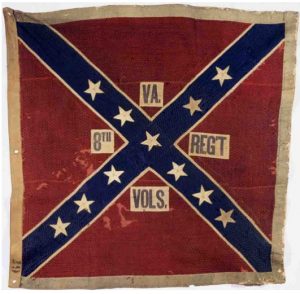Brothers in the 8th Virginia

The 8th Virginia Regiment charged toward the stonewall on Cemetery Ridge on July 3, 1863, as part of the Pickett-Pettigrew-Trimble Charge during the battle of Gettysburg. Sometimes called “The Bloody Eighth, this regiment lost nearly 70% of its strength in the charge. This regiment is difficult to determine official strengths and losses. According to one set of numbers, 243 men started the attack and only 75 answered roll call afterwards.
The regiment mustered at Leesburg in May 1861, after recruiting from surrounding counties in northern Virginia. Their baptism of fire took place at First Bull Run. During the Peninsula Campaign in 1862, the regiment boasted its highest enlistment number: 780 soldiers. Battles throughout that year along with the usual bouts of illnesses thinned the ranks prior to Gettysburg. As the Confederate Army of Norther Virginia headed into Pennsylvania during the summer of 1863, “The Bloody Eighth” marched in Garnett’s Brigade of Pickett’s Division.
On the afternoon of July 3 after an intense artillery barrage, the Confederate infantry attack intended to break the Federal center on Cemetery Ridge formed lines of battle and stepped off. The 8th had approximately three-quarters of a mile of open ground to cover. When the regiment hit the Emmitsburg Road and came in range of their enemy’s rifles, they angled toward the Codori Farm and mixed with regiments of Kemper’s brigade as they closed toward “The Angle.” By this time, all the 8th’s field officers and many of the company officers 0had been killed or wounded, leaving a lack of leadership. At least six of the regiment’s members reached the infamous stonewall. The 16th Vermont captured the battle flag.
Among the men who charged and fell in the ranks of the 8th Virginia at Gettysburg were several sets of brothers. While not uncommon in Civil War regiments, the large numbers of siblings in the regiment is noteworthy.
The Berkeley family had four soldiers in “The Bloody Eighth”—all brothers. They had been influential in recruiting the regiment, and sometimes the regiment went by its other nickname, “The Berkeley Regiment.” Three were wounded at Gettysburg. Norborne, the lieutenant colonel, and William, captain of Company D, were both shot near or just beyond the Codori farm. Their brother, Major Edmund Berkeley, also fell wounded nearby. The fourth brother, Charles, was captured at the stonewall.
Four brothers of the Presgrave family all fought in Company I. The regiment’s colonel, Eppa Hunton, laughingly called them “our twenty-four feet of Presgraves,” referencing their height—each boy was six feet or taller. All four boys numbered among the casualties at Gettysburg. John, who was a lieutenant, was shot in the leg, suffered an amputation, and died of gangrene of July 8. Both George and William were captured, eventually spending time in Fort Delaware. The regiment listed James as missing. However, some family lore claims that James took care of John while he lived, then buried his own brother, escaped the Union guards, and headed for home with the terrible news.
Another pair of brothers numbered among the men who reached the infamous stonewall. Benedict and Evans Lunceford huddled on their side of the wall. Evans loaded guns while Benedict shot. Eventually, they were forced to surrender.
One family of brothers helped to form and lead the regiment. Other brothers marched and fought side by side in the ranks. At Gettysburg, some of these siblings faced death together. Some survived. Some fell with bleeding wounds together. Some had to surrender and turn toward imprisonment. Perhaps one brother buried his brother.
Sometimes, the term “brothers’ war” is used for the American Civil War, usually with the concept of brothers fighting each other on different sides. However, accounts like these snippets from the 8th Virginia regimental history serve as a reminder that sometimes brothers were side by side on the battle lines. A devastating charge or other battle experience could fell a family’s boys, creating exponential loss and sorrow.
Sources:
John E. Devine, 8th Virginia Infantry, (Lynchburg: H.E. Howard, Inc., 1983).
Bierle’s research notes and files.
Thank you for this post
Thanks for referencing the “Pickett-Pettigrew-Trimble” attack! Wish other writers would do the same…
Maybe a dumb question, where are the top 2 stars on the battle flag?
Firing alongside the Lunceford Brothers was their cousin James D. Lunceford. He earned the reputation of killing the most men on the battlefield that day. Captured with the Lunceford brothers, they were sent to Ft. Delaware on Pea Patch Island. James acquired a lung infection and died in his bed on the 11th or 12th of March, 1864. Benjamin Richard “Benedict” and Evan Owen were paroled to the hospital at Richmond, VA and released at the close of the war.